Dog Show Judging
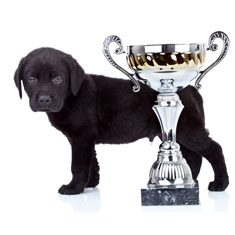
From the beginning…
All dog show judges start out as breeders and handlers. The most common way of qualifying as a judge is by using the 12-5-4 method in which the judge must have a minimum of 12 years of experience as a conformance exhibitor, must have bred five or more litters on his or her premises and must have bred four or more champions on his or her premises. The years of experience need be only in one of the breeds for which the judge is applying for certification, but the five litter and four champion requirements must be met for each breed for which certification is sought.
The American Kennel Club has also adopted an alternative method of qualification for those unable to meet the above 12-5-4 qualifications. Under the alternative program, the applicant must have at least 15 years of experience in conformation in any one of the breeds for which application is being made. In addition, the applicant must have accomplished any combination of four of the following:
- Bred and raised four litters in each breed on his or her premises
- Named AKC Breeder of Merit for one of the breeds applied
- Bred at least two champions in each breed requested
- Owned at least one dog in each breed requested, that has sired at least four champions while living on the premises of the applicant
- Personally exhibited four dogs to their championship in each breed requested Personally exhibited two dogs as specials in each breed requested for a minimum of two years (approximately 60 shows)
- Documented 25 years of experience exhibiting dogs in conformation
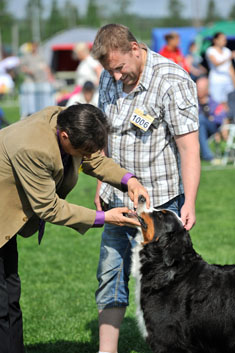
Disqualifying Occupations
In order to avoid the perception of favoritism, certain people are not permitted to become dog show judges. For example, if you or any member of your household is a professional handler for conformation, you cannot become a judge. Anyone who is a superintendent of a dog show cannot become a judge, nor can their employees. People who sell certain dog products such as food and kennel supplies are not permitted to become judges. However, other employees of dog product companies who do not have sales responsibilities may be certified as judges, provided that they do not judge at shows where their company’s services or products are offered.
Training
Each judge must, of course, be an expert on the breed standard for every breed he or she wants to judge. The breed standard specifies the color and texture of the dog’s coat, the size and shape of the dog, the shape of the eyes and ears, the color of the eyes and nose, and the temperament of the dog. After awhile, many of the standards can begin to sound the same, but there are subtle differences between each breed. The standards themselves are written and maintained by the parent club of each breed; i.e. the Beagle standard is the responsibility of the National Beagle Club of America and the Norwich Terrier Club of America writes the standard for Norwich Terriers.
In addition to having an in-depth understanding of each breed standard, each judge must attend an AKC –Sponsored Basic Judging Institute at some point in the two years prior to making his or her initial application. After they are certified, judges may choose to join the Dog Judges Association of America or American Dog Show Judges, Inc., both of which offer annual Advanced Judging Institutes to help judges keep their skills honed.
Testing
During the application process, judges must pass tests on both dog show procedures and dog anatomy. Could you do it? Below are some sample questions.
_____ 1. A judge may withhold a ribbon if:
- A. the dog has only one testicle but is not one year old
- B. the dog lacks sufficient merit
- C. the dog has been altered by surgical means
- D. the dog proves to be oversize or undersize for the class in which it is entered
_____ 2. After you place your dogs, but before you mark your book, a competing exhibitor lodges a protest alleging that your first place dog is lame. In this situation, you:
- A. deny they protest because it is impermissible to protest lameness
- B. call the veterinarian to assist you in making the determination
- C. regait the dog and if it is lame, excuse the dog, marking your book accordingly
- D. disqualify the dog
_____ 3. A protest may be made against a dog you are judging:
- A. by an individual outside the ring
- B. by an exhibitor in the ring up until the time you have marked the judge’s book
- C. by an exhibitor still in competition in the ring prior to every dog in the class being individually examined and gaited
- D. at any time during the judging of that breed
_____ 4. A judge must excuse any dog that
- A. menaces
- B. threatens
- C. exhibits any sign that it may not be examined in the normal manner
- D. all of the above
_____ 5. A judge with regular status in any breed should judge at least
- A. 20 dogs an hour
- B. 30 dogs an hour
- C. 25 dogs an hour
- D. 35 dogs an hour
_____ 6. Dudley nose is referred to as:
- A. flesh colored
- B. partially unpigmented, dark with flesh color
- C. roman nose
- D. pink
_____ 7. Strong, well-knuckled-up feet, cat feet, is referred to as:
- A. fused toes
- B. well-arched toes
- C. pigeon-toed
- D. east-west feet
_____ 8. Eye shapes include all except:
- A. almond
- B. oval
- C. globular
- D. china
_____ 9. Hocks turning in accompanied by turning out of the rear feet is referred to as:
- A. sickle hocked
- B. cow hocked
- C. hucklebones
- D. coupling
_____ 10. Domed, when describing the head, means
- A. curved or arched from stop to occiput
- B. thick and coarse through the skull
- C. gentle curving contours of the skull from ear to ear
- D. evenly rounded in topskull, not flat
Match the words from the Word Bank with the below definitions.
Word Bank
| A. Orbit | F. Haw | K. Barrel | P. Dapple |
| B. Undershot bite | G. Monorchid | L. Digit | Q. Flank |
| C. Cervical vertebrae | H. Pliant skin | M. Nape | R. Carpals |
| D. Cobby | I. Dewclaw | N. Dentition | S. Elbow |
| E. Ear flap | J. Jowls | O. Lateral | T. Loin |
1. _____ Synonym for toe
2. _____ A rib (thoracic) region that is circular in cross section
3. _____ Third eyelid or nicititating membrane in the medial (inside) corner of the eye
4. _____ A mottled or variegated coat color pattern
5. _____ The front teeth (incisors) of the lower jaw overlap or project beyond the front teeth of the upper jaw when the mouth is closed
6. _____ Forty-two adult teeth, including incisors, canines, premolar, and molars
7. _____ The bones of the wrist
8. _____ An extra claw or functionless (vestigial) digit on the inside of the leg; a rudimentary fifth toe
9. _____ Skin that is flexible
10. _____ The region of the body associated with the lumbar portion of the vertebrae (behind the ribs and before the pelvic girdle)
11. _____ The seven vertebrae of the neck, articulating anteriorly with the cranium and posteriorly with the thoracic vertebrae.
12. _____ A dog that has one testicle retained or hidden in its abdominal cavity
13. _____ The junction of the base of the skull and the top of the neck
14. _____ The side of the body between the last rib and the hip; the coupling
15. _____ The flesh of lips and jaws
16. _____ The eye socket
17. _____ Short-bodied, compact
18. _____ The joint in the front leg where the upper arm (humerus) meets the forearm (ulna)
19. _____ Pertaining to the side
20. _____ Ear leather
Click here for test answers. How did you do? Perhaps I should have mentioned that it is an open-book test? Much of the information can be found in the AKC’s glossary.
Finishing
Prospective judges must serve as dog show stewards, assembling the groups of dogs for their time in the show ring and assisting the judge, for at least six shows during the three years prior to application.
Prospective judges are interviewed by AKC field representatives before requesting to become provisional judges. As a provisional judge, the applicant must complete five judging assignments, three of which must be monitored by an AKC Executive Field Representative, before requesting “regular” status, which indicates that they are finally fully qualified.
When all of these qualifying events have been completed, the person who wishes to be a judge submits documentation proving he or she has met the requirements, along with the answer sheets from the tests, the appropriate fee, and an application form to the AKC and is notified in writing when he or she is certified.
Doggies Den: Latest Articles
 Homemade Thanksgiving Treats for Your Dog
Homemade Thanksgiving Treats for Your Dog
NUTRITION We all want to include our dogs in our holiday celebrations, but hopefully, you're aware that sharing table scraps with your dog isn't always the best idea.
 Keeping Your Dog Safe during the Summer Months
Keeping Your Dog Safe during the Summer Months
HEALTH Summer is coming on fast, so it’s time to plan how you will keep your dog safe and healthy through the lazy, carefree, warm days.
 Vaccination Time Again-Keeping Your Puppy Healthy
Vaccination Time Again-Keeping Your Puppy Healthy
DOG HEALTH So you have your new puppy picked out. There are quite a few shots, treatments and examinations that will keep the newest member of your family healthy.
 Canine Thanksgiving Feast
Canine Thanksgiving Feast
NUTRITION With the wide variety of food at Thanksgiving dinner, chances are you'll want to give your dog something special, too. If you're contemplating what to feed your dog for the holiday, here is a guide to a great Canine Thanksgiving Feast.
 Dog Walking Tips Every Owner Should Know
Dog Walking Tips Every Owner Should Know
DOG FUN Walking your dog is not only crucial to keeping him healthy and happy, it strengthens the bond between your canine friend and his caregiver. There are a lot of obstacles out there. Don’t forget these simple tips to keep your walk fun and safe in the outside world.
 The Benefits of Physiotherapy for your Dog
The Benefits of Physiotherapy for your Dog
HEALTH The same techniques that physiotherapists use to treat a variety of injuries and conditions in humans have been adapted to suit animals with great success. Family pets, show dogs, and working dogs can all benefit greatly from physiotherapy. Dogs whose activities involve a lot of agility are especially susceptible to the types of problems that physiotherapy can address.
 The Decision- Adding a Dog to Your Family
The Decision- Adding a Dog to Your Family
FIRST TIME OWNERSBringing a dog into your family is a decision where many people don’t realize it’s magnitude until after they have the dog. There are a number of things that you need to research before you decide to purchase a dog, and it starts right in your own home.
 Bringing Your Dog Into Your New Baby's Life
Bringing Your Dog Into Your New Baby's Life
HEALTH Many believe that a dog and a new baby cannot happily coexist, so therefore the dog has to go. This is not necessarily the case.  A new baby does not mean you have to abandon your dog.

Doggies Den:
Most Popular Articles

Dog Pregnancy Symptoms
HEALTHIf you suspect your dog might be pregnant, check out part one in this series on pregnant dogs, where we cover pregnant dog symptoms.
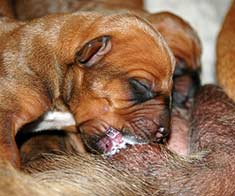
Dog Birth
HEALTHIn the third article of our dog pregnancy series, we look at the wonderful, but messy, process of bringing newborn puppies into the world.

Indoor Dog Potties
DOG PRODUCTSIt's been a long day at work. You were so busy, you didn't even take time to eat a sandwich, let alone run home to let your dog out. You're on your way home, knowing the poor dog is crossing his or her legs by now, when your car breaks down, delaying you even further. Can't somebody make this easier?
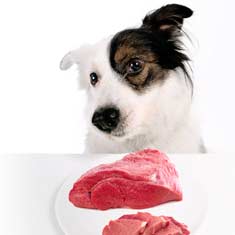
Your Dog’s Digestive System
PHYSIOLOGYEver wonder why your dog eats so fast? Or why he eats gross things? Or why he gets sick to his stomach? Or why his waste stinks so bad? Some of these things are normal, some are not.

Canine Respiratory System
BREATHINGThe basic function of your dog's respiratory system is to bring oxygen in to and remove carbon dioxide from the body. Knowing the symptoms of respiratory diseases can help you help your stay healthy.
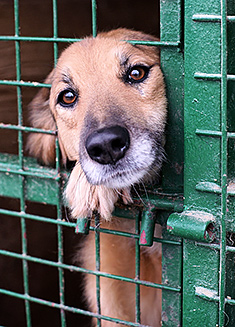
Shelter Dog Adoption Tips for Success
ADOPTION Are you intimidated by the prospect of "rescuing" a dog from a shelter? One reason that you may be wary of adopting a dog from a shelter is not knowing how to choose. Adopting a dog from a shelter can be a rewarding process, if you're prepared to do a reasonable amount of research.

Canine Urinary Tract Infections
SYMPTOMS AND TREATMENTDoes your dog seem to be having trouble relieving his or her bladder? Learn how to recognize the signs of urinary tract infections and how to treat them before they spread.

What to do for Dog Diarrhea
SYMPTOMS AND REMEDIESIf you have dogs in your house for any length of time, you have likely experienced at least one bout of dog diarrhea. Beyond the pain in the tuckus involved in cleaning up the mess, you should know what causes diarrhea, and when it's important to see the vet.
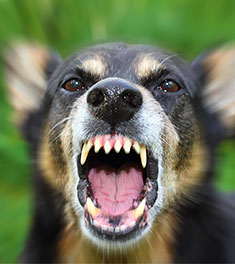
What to do for a Dog Bite
DOG BEHAVIOR Getting bitten by a dog can be scary, and you may be tempted to run around in circles for a while, trying to figure out what to do. Here's our guide to help you manage the situation.

Top Ten Tips for Living with a Senior Dog
DOG HEALTH Bringing home a new puppy is so exciting, but it doesn’t take all that long for your exuberant puppy to grow into a senior dog who may have special needs. Here are the doggies.com top ten tips for taking care of your companion who has been with you through so much.
